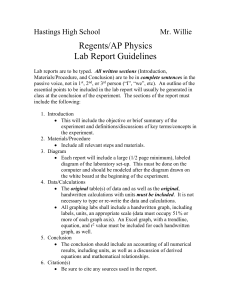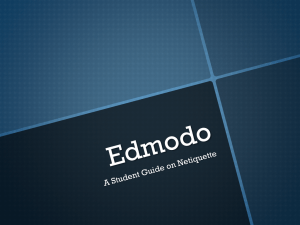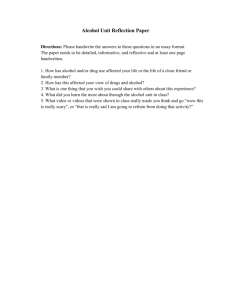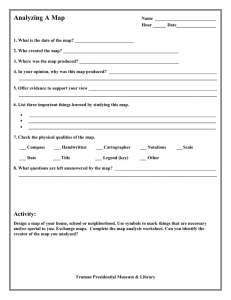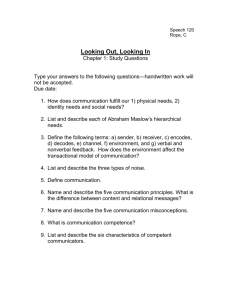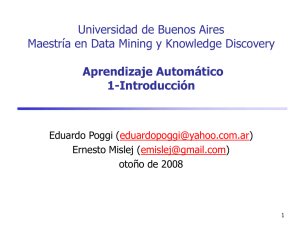AP World History Introduction and Summer Work
advertisement
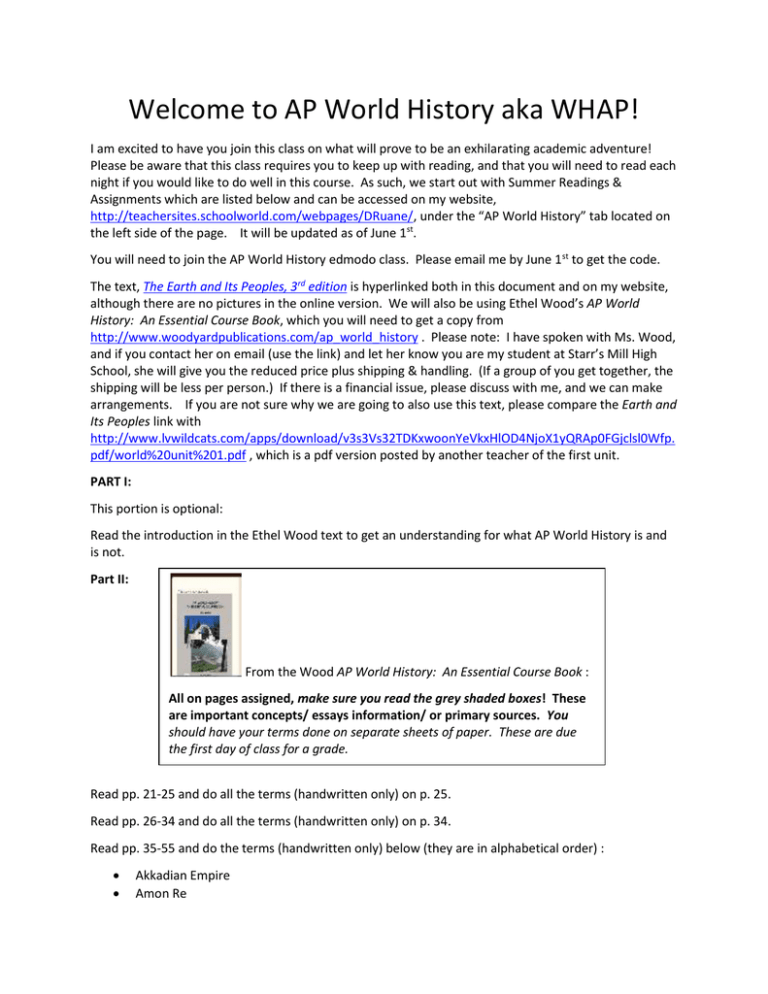
Welcome to AP World History aka WHAP! I am excited to have you join this class on what will prove to be an exhilarating academic adventure! Please be aware that this class requires you to keep up with reading, and that you will need to read each night if you would like to do well in this course. As such, we start out with Summer Readings & Assignments which are listed below and can be accessed on my website, http://teachersites.schoolworld.com/webpages/DRuane/, under the “AP World History” tab located on the left side of the page. It will be updated as of June 1st. You will need to join the AP World History edmodo class. Please email me by June 1st to get the code. The text, The Earth and Its Peoples, 3rd edition is hyperlinked both in this document and on my website, although there are no pictures in the online version. We will also be using Ethel Wood’s AP World History: An Essential Course Book, which you will need to get a copy from http://www.woodyardpublications.com/ap_world_history . Please note: I have spoken with Ms. Wood, and if you contact her on email (use the link) and let her know you are my student at Starr’s Mill High School, she will give you the reduced price plus shipping & handling. (If a group of you get together, the shipping will be less per person.) If there is a financial issue, please discuss with me, and we can make arrangements. If you are not sure why we are going to also use this text, please compare the Earth and Its Peoples link with http://www.lvwildcats.com/apps/download/v3s3Vs32TDKxwoonYeVkxHlOD4NjoX1yQRAp0FGjclsl0Wfp. pdf/world%20unit%201.pdf , which is a pdf version posted by another teacher of the first unit. PART I: This portion is optional: Read the introduction in the Ethel Wood text to get an understanding for what AP World History is and is not. Part II: From the Wood AP World History: An Essential Course Book : All on pages assigned, make sure you read the grey shaded boxes! These are important concepts/ essays information/ or primary sources. You should have your terms done on separate sheets of paper. These are due the first day of class for a grade. Read pp. 21-25 and do all the terms (handwritten only) on p. 25. Read pp. 26-34 and do all the terms (handwritten only) on p. 34. Read pp. 35-55 and do the terms (handwritten only) below (they are in alphabetical order) : Akkadian Empire Amon Re Amulets Aryans Assyrians Babylonians Book of the Dead Cataracts City-state Civilization (7 characteristics) Cultural diffusion Cultural hearths Cuneiform Dravidian Dynasty (dynastic cycles) Epic of Gilgamesh Ferticle Crescent Hammurabi Hammurabi’s Code Harappa Hatshepsut Hittites Horus Hyksos Isis Labor systems Law code Ma’at Menes Mesopotamia Middle Kingdom Mohenjo-Daro Monsoon rains New Kingdom Old Kingdom Papyrus Patriarchy Pharaoh Pictographs Rosetta Stone Semitic Sumerians Systems failure Theocracy ziggurats You will need to complete the following by the first day of school in your own handwriting, and there will be a quiz on this summer reading as soon as the first day of school—but definitely within the first week. PART II: REQUIRED BOOKS: These books will be used later in the course as well so it is highly recommended that students purchase a copy. If there is a financial issue, please contact me. Introduction, Chapter 1, and Chapter 2 in A History of the World in Six Glasses, by Tom Standage. Use Cornell Notes format and directions (both below) to take notes on this book. A. On the left side of the notebook, you are to take reading notes on each chapter. For each chapter, these must include: the main ideas of each chapter, an explanation of what the author is discussing and specific examples. These may be in bulleted form. B. On the right side, you are to write your thoughts about what you are reading, in context to history and geography, and you are to write the key vocabulary words (with definitions), and the key people in each chapter ( with a brief explanation of who they are). For the right side, you will need to create a specific pattern that you want to follow as you read each chapter. LEFT SIDE Cornell-style Notes: Chapter 1: Title Your reading notes will go on these pages. You should have the one or two main ideas of each chapter, an explanation of what the author is discussing and specific examples from the reading. RIGHT SIDE Thoughts and Reflections on Ch. One: Title 1. Your thoughts based on the context of world history and geography. 2. Vocabulary with definitions 3. Key individuals with explanations 4. Any things you did not understand in the chapter. Chapter 1 on Xuanzang and Chapter 10 in When Asia was the World, by Stewart Gordon. Take notes on each chapter as you see fit, but no more than one page for each chapter, and they must be HANDWRITTEN. Especially important to note are the following themes: 1) Religion 2) commodities – books, silk (robes!), spices, etc. 3) communication between people of different languages and cultures You will turn in notes on these books for a grade the first day of school. One of the biggest things you can do over the summer (and it is true for the rest of the year in AP World History) is do not get behind. There is too much information to read, so I recommend you start with the study guides first, and then go on to the excerpts from A History of the World in 6 Glasses and When Asia was the World. Join the AP World History edmodo group by the June 1st. This is a primary means of communication for me to my students, and for you to use with your classmates. You will need to email me for the edmodo code (each one is different) at ruane.diane@mail.fcboe.org. -Mrs. Ruane
